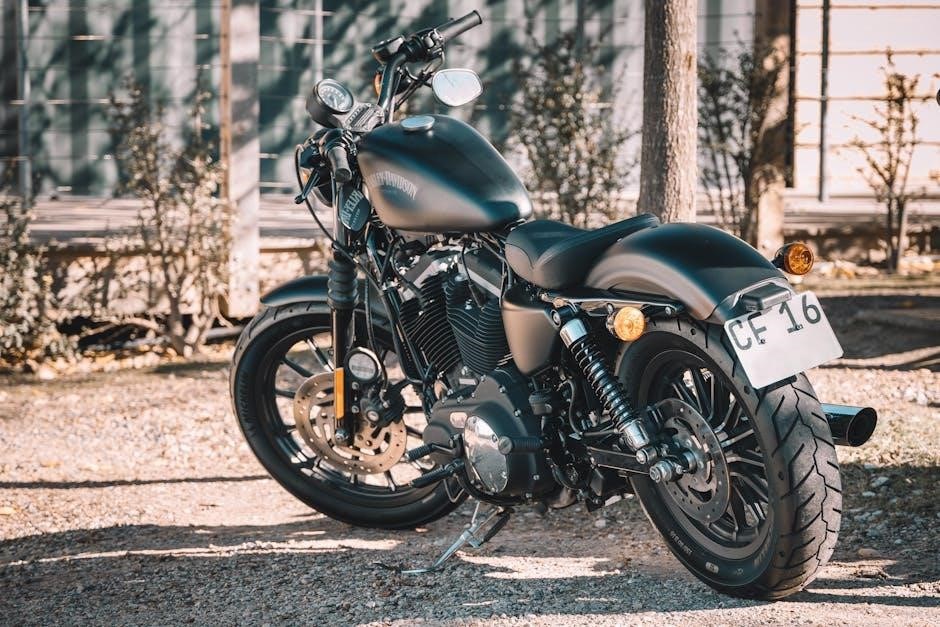Choosing the right bike can be overwhelming, but with the right guide, you’ll make an informed decision. Explore types, budgets, and key features to find your perfect match.
Understanding Your Needs
Before buying a bike, reflect on your riding habits and preferences. Where will you ride most often—on paved roads, trails, or city streets? Consider the type of cycling you’ll do, whether for fitness, commuting, or leisure. Think about how frequently you’ll ride and the distance you typically cover. Your lifestyle and personal goals will help narrow down the best bike for you. For example, if you plan to ride daily, durability and comfort become priorities. If you’re commuting, practicality and storage may matter. Understanding these factors ensures you choose a bike that meets your needs and enhances your cycling experience.
Setting a Budget
Setting a budget is crucial when buying a bike to avoid overspending. Bikes vary widely in price, from affordable options to high-end models. Determine how much you’re willing to spend, considering both the bike and accessories like a helmet or lock. Entry-level bikes start around $300-$500, while mid-range models fall between $800-$1,500. High-performance bikes can exceed $2,000. Consider whether you’ll need additional gear and factor that into your budget. Stick to your range to find a bike that offers value and meets your needs without financial strain. A clear budget helps narrow your choices and simplifies the decision-making process.
Types of Bikes
Bikes come in various types, each designed for specific terrains and purposes. From road bikes to mountain, hybrid, electric, and touring bikes, there’s a perfect fit for every rider.
Road Bikes
Road bikes are designed for speed and efficiency on paved surfaces. They typically feature lightweight frames, narrow tires, and aerodynamic designs. Ideal for fitness enthusiasts and competitive riders, road bikes offer a wide range of gearing for tackling varied terrain. They are also a great choice for triathletes due to their versatility; When choosing a road bike, consider factors like frame material, handlebar style, and the number of gears to ensure it meets your riding needs and preferences.
Mountain Bikes
Mountain bikes are designed for off-road adventures, offering durability and stability on rough terrains. They feature wide, knobby tires for traction and robust frames to withstand impacts. Suspension systems, either front-only (hardtail) or full (full-suspension), absorb shocks for a smoother ride. These bikes are ideal for trails, hills, and technical courses, catering to both casual riders and advanced cyclists. When selecting a mountain bike, consider the type of suspension, wheel size, and frame material to suit your riding style and the terrain you’ll encounter most often.
Hybrid and Cruiser Bikes
Hybrid and cruiser bikes combine elements of road and mountain bikes, offering versatility for various riding conditions. They feature upright handlebars for comfort, wide tires for stability, and lightweight frames for ease of handling. Ideal for city commutes, casual rides, or light trails, these bikes prioritize comfort and practicality. Cruiser bikes often have a relaxed, retro design, while hybrids are more performance-oriented. Both are great for riders seeking a balance between speed and comfort, making them perfect for everyday use or leisurely adventures.
Electric Bikes
Electric bikes, or e-bikes, are a modern, convenient option for riders seeking assistance with pedaling. They feature integrated electric motors and batteries, offering varying levels of power depending on the model. E-bikes are ideal for commuting, long distances, or tackling challenging terrains with ease. Many models allow you to switch between pedal-assist and throttle modes, providing flexibility. With their environmentally friendly design and low maintenance, e-bikes are becoming increasingly popular. They’re perfect for those who want to enjoy cycling without the physical strain, making them a practical choice for both casual and serious riders.
Touring Bikes
Touring bikes are designed for long-distance travel, offering durability and comfort for riders carrying gear. Built with sturdy frames, often made of steel or aluminum, they feature mounting points for panniers, fenders, and water bottles. These bikes are versatile, handling paved roads, gravel paths, and light trails with ease. A comfortable, upright riding position and wide-range gearing make them ideal for multi-day adventures. Whether you’re exploring new regions or embarking on a cross-country journey, touring bikes provide the reliability and practicality needed for extended trips.
Key Considerations
When buying a bike, prioritize purpose, fit, and budget. Ensure the bike meets your riding style, offers comfort, and aligns with your spending limits for long-term satisfaction.
Purpose and Usage
Understanding your riding purpose is crucial. Will you ride on paved roads, trails, or city streets? Determine if you need a bike for commuting, fitness, or recreation. Different terrains require specific bike types—road bikes for speed, mountain bikes for rough trails, and hybrids for versatility. Consider how often and how far you’ll ride, as this impacts durability and comfort needs. Your primary usage will guide the choice of frame, gears, and accessories, ensuring the bike matches your lifestyle and preferences for years of enjoyable riding.
Fit and Sizing
Proper fit and sizing are essential for a comfortable and efficient riding experience. The right frame size, seat height, and handlebar height ensure optimal performance and reduce the risk of discomfort or injury. Test rides are crucial to determine how the bike feels. Standover clearance is a key factor—about 1-2 inches for road bikes and more for mountain bikes. Consider your riding position: aerodynamic for speed or upright for comfort. Correct fit enhances control and enjoyment, making every ride more satisfying.
Cost Factors
Cost factors vary widely depending on the type of bike and its components. High-end materials like carbon fiber or advanced gear systems increase prices. Accessories and customizations also add to the total cost. Local shops may offer assembly and tuning, which can influence pricing. Online retailers often provide competitive rates but require self-assembly. Budget bikes are affordable but may lack premium features. Mid-range options balance quality and affordability, while high-end bikes offer superior performance. Consider your usage and priorities to choose a bike that fits your budget without compromising on essential features for your riding needs.

Components and Accessories
Key components include frames, wheels, seats, and handlebars. Accessories like helmets, lights, and locks enhance safety and convenience. Quality materials and proper fit ensure optimal performance.
Gears and Drivetrain
The drivetrain is a critical component of your bike, transferring power from the pedals to the wheels. Gears determine how easy or hard it is to pedal, with options ranging from single-speed to multi-gear systems. Derailleurs or internal gear hubs are common mechanisms for shifting gears. The number of gears depends on the bike type—road bikes often have 18-22 gears, while mountain bikes may have 12-27 for tackling rough terrain. A well-maintained drivetrain ensures smooth, efficient riding. Regular cleaning and lubrication of the chain and cogs are essential for longevity and performance.
Brakes and Safety Features
Brakes are a crucial component for control and safety. Disc brakes offer superior stopping power in wet conditions, while rim brakes are lighter and easier to maintain. Hydraulic disc brakes provide consistent performance, though they can be more expensive. Regular maintenance of brake pads and cables is essential for reliability. Additional safety features include reflective tires, built-in lights, and puncture-resistant tires. Always wear safety gear, such as a helmet, to protect yourself. Consider accessories like bells or mirrors for added visibility and awareness. Choosing the right braking system and maintaining it properly ensures a safer riding experience.
Frame Materials
Frames are made from various materials, each offering unique benefits. Steel frames are durable and provide a smooth ride but are heavier. Aluminum frames are lightweight, corrosion-resistant, and affordable, making them a popular choice. Carbon fiber frames are ultra-lightweight and stiff, ideal for high-performance bikes, though they can be expensive. Titanium frames combine strength, light weight, and durability but are costly. The choice of frame material depends on your budget, riding style, and terrain. Consider factors like comfort, weight, and durability when selecting the right frame for your needs.
Essential Accessories
Equipping your bike with the right accessories enhances safety, comfort, and functionality. A high-quality helmet is a must for protection, while front and rear lights improve visibility. A sturdy lock ensures security, and a water bottle cage keeps you hydrated on long rides. Padded gloves and comfortable saddles can reduce fatigue. Additionally, a basic multi-tool and spare tubes are crucial for minor repairs. While extra gear can be added later, these essentials are immediate needs for a safe and enjoyable cycling experience. Prioritize them to get the most out of your biking adventures.
Where to Buy
Explore local bike shops for personalized service, online retailers for convenience, or certified pre-owned options for quality and affordability. Choose what best fits your needs.
Local Bike Shops
Local bike shops offer personalized service, expert advice, and the chance to test ride bikes. They provide professional fitting, ensuring optimal comfort and performance. Many shops also offer maintenance tips and post-purchase support. Buying locally supports your community and builds a relationship with knowledgeable staff. You’ll find a wide range of models, and experts can guide you through the decision-making process; Additionally, local shops often host events and workshops, fostering a sense of cycling community. Visit a local bike shop for a tailored experience and reliable after-sales care.
Online Retailers
Online retailers offer a vast selection of bikes and accessories, often with competitive pricing and customer reviews to guide your decision. Many provide detailed product descriptions, sizing charts, and video tutorials to help you choose the right bike. While some assembly is typically required, home delivery adds convenience. However, test rides are usually unavailable, and fitting may require adjustments. Look for retailers with clear return policies and good customer support. Online forums and reviews can also provide insights to ensure you make an informed purchase. Always verify the retailer’s reputation to avoid scams and ensure a smooth buying experience.
Certified Pre-Owned Options
Certified Pre-Owned (CPO) bikes are gently used models that have been inspected and refurbished to meet specific standards. They often come with warranties and are sold through reputable dealers. CPO bikes provide a cost-effective way to own a high-quality bike, as they are typically priced lower than new models but still offer reliable performance. The certification process ensures the bike is in excellent condition, with any worn parts replaced. This option is ideal for budget-conscious buyers or those looking to test the waters before committing to a brand-new bike. It also supports sustainability by giving bikes a second life.

Test Rides and Warranty
A test ride is essential to ensure the bike feels right for you. It allows you to assess comfort, handling, and performance in real-world conditions. Always take advantage of this opportunity before purchasing. A good warranty provides peace of mind, typically covering frame defects and components for a specified period. Look for warranties that cover materials and workmanship for at least a few years. Some manufacturers offer extended warranties for additional security. Be sure to ask about what’s included and any limitations. A solid warranty reflects the manufacturer’s confidence in their product.

Maintenance and Care
Regular maintenance is crucial to ensure your bike performs optimally and lasts longer. Clean your bike frequently, paying attention to the chain, gears, and brakes. Lubricate the chain regularly to prevent rust and wear. Check tire pressure before each ride and inspect for punctures or damage. Store your bike in a dry place to protect it from rust. Schedule professional tune-ups annually or as needed. Keep a basic toolkit handy for minor adjustments. Proper care will keep your bike running smoothly and ensure your safety on the road or trail.
Buying the right bike is a significant decision that enhances your cycling experience. Consider your needs, budget, and lifestyle to make an informed choice. Whether for commuting, recreation, or adventure, the right bike will provide years of enjoyment. Remember, proper fit and maintenance are key to ensuring safety and performance. Take your time, test ride options, and don’t hesitate to seek advice. Once you’ve found the perfect bike, hit the road or trail with confidence and enjoy the freedom cycling offers!





